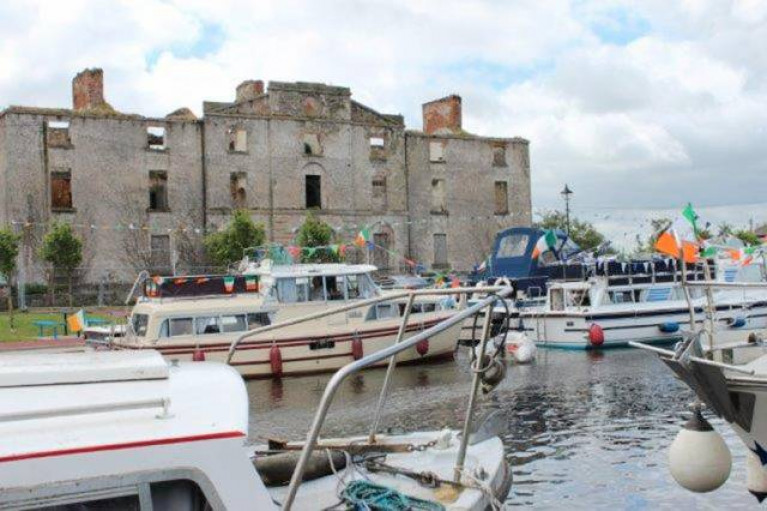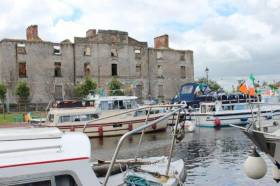Displaying items by tag: Shannon Harbour
Derelict Boats On View Ahead of Waterways Ireland Sale
Boating enthusiasts converged on Shannon Harbour on Saturday (2 March) to view the 16 boats being auctioned by Waterways Ireland after their removal from the inland waterways.
As previously reported on Afloat.ie, offers may be submitted until noon on Friday 15 March for each of the vessels which come in variable size, style and condition.
According to RTÉ News, previous offers have ranged from as low as €50 to as much as €8,000.
And with the growth in popularity of boat restoration projects, these unloved vessels may fetch higher prices than expected.
RTÉ News has more on the story HERE.
Waterways Ireland Announces New Sale of Craft Removed from Navigations
Waterways Ireland proposes to dispose, by public tender, of a number of vessels removed from the inland waterways under its purview.
Sixteen vessels are presently stored by Waterways Ireland at Shannon Harbour, Co Offaly on the Grand Canal. All vessels may be inspected (externally only) between 11am and 3pm next Saturday 2 March.
All vessels are sold as seen, intended as obsolete items. Lots will be sold as individual items only, to the highest acceptable tender.
The vessel catalogue and tender submission form are available from the Waterways Ireland website.
Sealed tenders should reach the Assistant Inspector of Navigation at the Inspectorate office, Waterways Ireland, Harbour Street, Tullamore, Co Offaly (Tel 057 932 5019) no later than noon on Friday 15 March. Please note only postal submissions will be accepted.
Only successful tenders will be notified by email from the details supplied.
A condition of sale is that vessels be removed from Waterways Ireland property once purchased.
Waterways Ireland will provide a crane to remove vessels from the impound lot. A small sum will be added to each tender to facilitate the crane hire (€100-€150). Bidders must provide their own suitable transport/trailer to remove vessels from the pound.
Grand Canal: Shannon Harbour Jetty Closure for Maintenance Works
Waterways Ireland advises masters and owners of vessels that it will be carrying out maintenance works on the waiting jetty on the upstream side of the 35th Lock in Shannon Harbour.
Works will begin on Monday 29 January and will last for four weeks, from 9am to 5pm each day. The jetty will be closed during this time, the cross-border body for Ireland’s inland waterways says.
Grand Canal: Update on Lock Operation at Shannon Harbour
Waterways Ireland advises masters of vessel on the Grand Canal that due to the ongoing works at Shannon Harbour, passage through Locks 35 and 36 will only be possible by prior arrangement with the Waterway Patroller.
This system will be in place until Tuesday 21 November, the cross-border body for Ireland’s inland waterways adds.
Operation of the locks will be controlled by the Waterway Patroller and only during working hours, as follows:
- Until 31 October: 9.30am to 4.45pm (lunch break 1-1.30pm).
- 1 November to 15 March: 9.30am to 2pm (lunch break 1-1.30pm).
To arrange passage through Locks 35 and 36, use the following numbers:
- For passage from Monday to Sunday (excluding Friday), call 087 245 6587.
- For passage on a Friday, call 087 245 6609.
Waterways Ireland thanks its customers for their cooperation.
Grand Canal: Device Installation for Green WIN Project at Shannon Harbour
Waterways Ireland advises all masters of vessels on and users of the Grand Canal that as part of the Green WIN project (more HERE), new deep well and flow devices are to be installed at Locks 35 and 36 at Shannon Harbour.
These works are due to begin Monday 25 September and will continue for around eight weeks, until mid-to-late November.
The works are land-based and navigation through the locks will not be affected, the cross-border body for Ireland’s inland waterways adds.
Grand Canal: Quay Wall Repairs at Shannon Harbour
Waterways Ireland advises all masters of vessels on and users of the Grand Canal that it will be carrying out maintenance works on a damaged section of the north quay wall in Shannon Harbour.
Works will begin on Monday 25 September and will last around seven weeks until mid November, from 9am to 5pm each day.
A section of the harbour wall will be closed off to boat users during this time.
The access road to the north of Shannon Harbour will also be closed to public traffic and only local traffic will be permitted access.
Water levels in Shannon Harbour may have to be lowered for a time to allow these works to be completed, the cross-border body for Ireland’s inland waterways adds.
Grand Canal: Diving Operations in Shannon Harbour
Waterways Ireland advises all masters of vessels on and users of the Grand Canal that it will be carrying out underwater structural inspections of the north and south quay walls in Shannon Harbour this coming week.
Divers will be in the water between Griffith Bridge and the 35th Lock on Wednesday 20 and Thursday 21 September (rescheduled from Monday 18 and Tuesday 19 September) between 9am and 5pm each day. An Alpha Flag (Divers Flag) will be flown to indicate the divers’ presence.
Waterways Ireland says it will be required to move vessels for the inspection and will return boats to their original positions when completed.
Boat owners are advised to check mooring lines of their boats after the work is completed, the cross-border body for Ireland’s inland waterways adds.
Shannon Harbour Vessels Put Up For Sale
A number of vessels seized and removed from Shannon Harbour by Waterways Ireland will be disposed of in a sale this month.
All vessels available will be sold as seen, in individual lots, to the highest acceptable tender price.
Completed tender documents must be returned to Waterways Ireland before 12 noon on Wednesday 16 September.
This year’s Shannon Harbour Canal Boat Rally, which had been scheduled for 19-21 June, has been postponed over the coronavirus pandemic.
Ian Skelton, Hon Sec of the Inland Waterways Association of Ireland’s Shannon Harbour branch and who confirmed the news, said it is hoped to have some sort of gathering in the rally’s stead later in the year if the situation improves.
This would have been the 49th edition of the rally, the running of which was taken over by Shannon Harbour IWAI two years ago.
Elsewhere, the Barrow Awards 2020 have been cancelled due to the ongoing Covid-19 situation, as reported by John Dimond of Barrow IWAI.
The award scheme promotes groups all along the River Barrow to focus on and improve their river frontage and acknowledges their efforts.
The awards have been supported by the county councils adjoining the Barrow, chaired by Eileen O’Rourke of Carlow County Council and with the backing of Waterways Ireland.
Shannon Harbour Canal Boat Rally Is Back On The Agenda
#Heritage - The Shannon Harbour Canal Boat Rally will go ahead this month, despite reports of its recent cancellation.
Afloat.ie has learned that a new voluntary group has taken over the hosting of the rally, after Inland Waterways Association of Ireland (IWAI) Shannon Harbour branch chair Damien Buckley announced it would no longer be running.
Gerry Burke of the IWAI’s Lough Derg branch led the charge to maintain the tradition of the heritage event during the recent Jamestown Heritage Festival in Kildare.
It means 2018 will indeed mark the 47th edition of the Shannon Harbour Canal Boat Rally, which will take place over the weekend of Friday 15 to Sunday 17 June.


























































